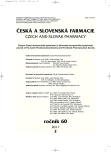Generic substitution, replacement and substitution of drugs: contemporary extent
Authors:
Božena Macešková 1; Renata Blechová 2; Eva Blahožová 1; Kateřina Hadámková 1
Authors‘ workplace:
Veterinární a farmaceutická univerzita Brno, Farmaceutická fakulta, Ústav aplikované farmacie
1; Veterinární a farmaceutická univerzita Brno, Farmaceutická fakulta, Ústav humánní farmakologie a toxikologie
2
Published in:
Čes. slov. Farm., 2011; 60, 73-78
Category:
Original Articles
Overview
When dispensing the medication, the dispensing chemist should inform the patient about the possible alternatives to the medicament dispensed and, with his consent, he can replace it with another preparation of identical properties (a generic drug, a bioequivalent preparation) in case it is not forbidden by the physician. A replacement of the prescribed drug is performed in the case that the required preparation is not in stock and its immediate dispensation is necessary. The present paper compares the prices of generics and original preparations and the extent of replacements and substitutions. The method employed was an analysis of data about dispensation in pharmacies. Of 61 generics under study, 10 preparations had a higher price than the original ones. Replacements and substitutions were monitored for a period of 1 year in preparations containing 14 selected active ingredients. Instead of the prescribed preparations containing omeprazole and ranitidine (26 HVLP), generics were dispensed in 31.0 %, i.e. 157 cases (113 of it were substitutions). In the groups of drugs used for high blood pressure therapy (9 active ingredients, 63 kinds of mass-produced preparations), generics were dispensed in 14.5 %, i.e. 120 cases (112 cases of it were substitutions). Instead of the prescribed preparations containing simvastatin, atorvastatin and fenofibrate (42 mass-produced preparations), generics were dispensed in 17.5 %, i.e. 82 cases (67 cases of it were substitutions). The found percentage of realized generic substitutions is low (6.2 %–28.0% according to the type of the active ingredient) when calculated to the total amount of the performed replacements and substitutions.
Key words:
substitution – replacement – generic substitution – generics – ATC group
Sources
1. Zákon 378/2007 Sb., o léčivech, v platném znění.
2. Vyhláška 84/2008 Sb., o správné lékárenské praxi, v platném znění.
3. Zákon 48/1997 Sb.,o veřejném zdravotním pojištění a o změně a doplnění některých souvisejících zákonů, v platném znění.
4. Dukes, M. N. G., Haaijer-Ruskamp, F. M., de Joncheere, C. P. et al.: Drugs and Money - proces, affordability and cost contaiment. 7th ed. Amsterodam: IOS Press 2003; 152. 5. Vyhláška 255//2003 Sb., kterou se stanoví správná lékárenská praxe.
5. vyhláška 255//2003 Sb., kterou se stanoví správná lékárenská praxe.
6. Metyš, K., Balog, P.: Marketing ve farmacii. 1. vydání Praha: Grada Publishing 2006; 205 s.
7. Mrazek, M., Mossialos, E.: Increasing demand while decreasing cistis generic medicines. Lancet 2000; 356, 1784–1785.
8. Turnbull, A.: Generic Medicines in Europe. http://www. egagenerics.com/gen-geneurope.htm (15. 12. 2010).
9. Greg, P.: The European Generic Pharmaceutical Market in Review: 2006 and beyond. http://www.egagenerics. com/doc/jgm_generics2006-gp.pdf (12. 2. 2009).
10. Kolektiv: Zaměřeno na generickou substituci. Pharm business magazin 2008; 4(2): 48–50.
11. Hořejší, J.: Farmacie 2008 – diskuze o faktech. Medical Tribune 2008; 4, A10.
12. -: Generická substituce bez problémů. Medical Tribune 2008; 4, A7.
13. Juřicová, V.: Generická substituce z pohledu lékařů. Diplomová práce. Brno: FaF VFU 2010.
14. Gajdušková, L.: Náhrady předepsaných léčivých přípravků. Rigorózní práce. Brno: FaF VFU 2009.
15. Hassali, M., Shafie, A., Jamshed, S., Ibrahim, M., Awaisu, A.: Consumers’ views on generic medicines. A review of the literature. International Journal of Pharmacy Practice 2002; 17, 79–88.
16. AISLP verze 2009.4.
Labels
Pharmacy Clinical pharmacologyArticle was published in
Czech and Slovak Pharmacy

2011 Issue 2
Most read in this issue
- Generic substitution, replacement and substitution of drugs: contemporary extent
- Myasthenia gravis – current treatment standards and emerging drugs
- Bacteriocins produced by lactic acid bacteria
- Pelletization of melts and liquids
